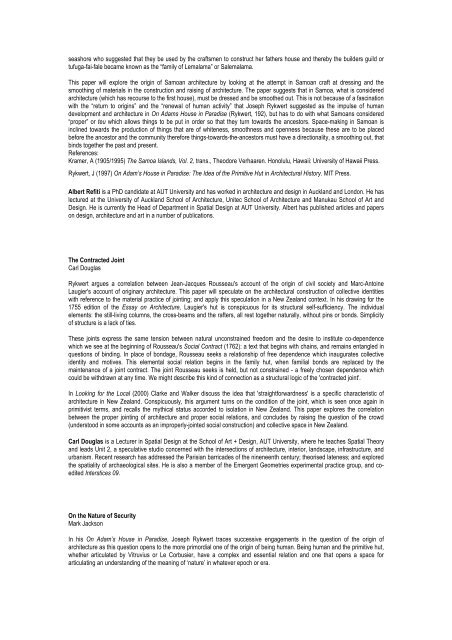On Adam's House in the Pacific - Scholarly Commons Home
On Adam's House in the Pacific - Scholarly Commons Home
On Adam's House in the Pacific - Scholarly Commons Home
You also want an ePaper? Increase the reach of your titles
YUMPU automatically turns print PDFs into web optimized ePapers that Google loves.
seashore who suggested that <strong>the</strong>y be used by <strong>the</strong> craftsmen to construct her fa<strong>the</strong>rs house and <strong>the</strong>reby <strong>the</strong> builders guild or<br />
tufuga-fai-fale became known as <strong>the</strong> “family of Lemalama” or Salemalama.<br />
This paper will explore <strong>the</strong> orig<strong>in</strong> of Samoan architecture by look<strong>in</strong>g at <strong>the</strong> attempt <strong>in</strong> Samoan craft at dress<strong>in</strong>g and <strong>the</strong><br />
smooth<strong>in</strong>g of materials <strong>in</strong> <strong>the</strong> construction and rais<strong>in</strong>g of architecture. The paper suggests that <strong>in</strong> Samoa, what is considered<br />
architecture (which has recourse to <strong>the</strong> first house), must be dressed and be smoo<strong>the</strong>d out. This is not because of a fasc<strong>in</strong>ation<br />
with <strong>the</strong> “return to orig<strong>in</strong>s” and <strong>the</strong> “renewal of human activity” that Joseph Rykwert suggested as <strong>the</strong> impulse of human<br />
development and architecture <strong>in</strong> <strong>On</strong> Adams <strong>House</strong> <strong>in</strong> Paradise (Rykwert, 192), but has to do with what Samoans considered<br />
“proper” or teu which allows th<strong>in</strong>gs to be put <strong>in</strong> order so that <strong>the</strong>y turn towards <strong>the</strong> ancestors. Space-mak<strong>in</strong>g <strong>in</strong> Samoan is<br />
<strong>in</strong>cl<strong>in</strong>ed towards <strong>the</strong> production of th<strong>in</strong>gs that are of whiteness, smoothness and openness because <strong>the</strong>se are to be placed<br />
before <strong>the</strong> ancestor and <strong>the</strong> community <strong>the</strong>refore th<strong>in</strong>gs-towards-<strong>the</strong>-ancestors must have a directionality, a smooth<strong>in</strong>g out, that<br />
b<strong>in</strong>ds toge<strong>the</strong>r <strong>the</strong> past and present.<br />
References:<br />
Kramer, A (1905/1995) The Samoa Islands, Vol. 2, trans., Theodore Verhaaren. Honolulu, Hawaii: University of Hawaii Press.<br />
Rykwert, J (1997) <strong>On</strong> Adam’s <strong>House</strong> <strong>in</strong> Paradise: The Idea of <strong>the</strong> Primitive Hut <strong>in</strong> Architectural History. MIT Press.<br />
Albert Refiti is a PhD candidate at AUT University and has worked <strong>in</strong> architecture and design <strong>in</strong> Auckland and London. He has<br />
lectured at <strong>the</strong> University of Auckland School of Architecture, Unitec School of Architecture and Manukau School of Art and<br />
Design. He is currently <strong>the</strong> Head of Department <strong>in</strong> Spatial Design at AUT University. Albert has published articles and papers<br />
on design, architecture and art <strong>in</strong> a number of publications.<br />
The Contracted Jo<strong>in</strong>t<br />
Carl Douglas<br />
Rykwert argues a correlation between Jean-Jacques Rousseau's account of <strong>the</strong> orig<strong>in</strong> of civil society and Marc-Anto<strong>in</strong>e<br />
Laugier's account of orig<strong>in</strong>ary architecture. This paper will speculate on <strong>the</strong> architectural construction of collective identities<br />
with reference to <strong>the</strong> material practice of jo<strong>in</strong>t<strong>in</strong>g; and apply this speculation <strong>in</strong> a New Zealand context. In his draw<strong>in</strong>g for <strong>the</strong><br />
1755 edition of <strong>the</strong> Essay on Architecture, Laugier's hut is conspicuous for its structural self-sufficiency. The <strong>in</strong>dividual<br />
elements: <strong>the</strong> still-liv<strong>in</strong>g columns, <strong>the</strong> cross-beams and <strong>the</strong> rafters, all rest toge<strong>the</strong>r naturally, without p<strong>in</strong>s or bonds. Simplicity<br />
of structure is a lack of ties.<br />
These jo<strong>in</strong>ts express <strong>the</strong> same tension between natural unconstra<strong>in</strong>ed freedom and <strong>the</strong> desire to <strong>in</strong>stitute co-dependence<br />
which we see at <strong>the</strong> beg<strong>in</strong>n<strong>in</strong>g of Rousseau's Social Contract (1762): a text that beg<strong>in</strong>s with cha<strong>in</strong>s, and rema<strong>in</strong>s entangled <strong>in</strong><br />
questions of b<strong>in</strong>d<strong>in</strong>g. In place of bondage, Rousseau seeks a relationship of free dependence which <strong>in</strong>augurates collective<br />
identity and motives. This elemental social relation beg<strong>in</strong>s <strong>in</strong> <strong>the</strong> family hut, when familial bonds are replaced by <strong>the</strong><br />
ma<strong>in</strong>tenance of a jo<strong>in</strong>t contract. The jo<strong>in</strong>t Rousseau seeks is held, but not constra<strong>in</strong>ed - a freely chosen dependence which<br />
could be withdrawn at any time. We might describe this k<strong>in</strong>d of connection as a structural logic of <strong>the</strong> 'contracted jo<strong>in</strong>t'.<br />
In Look<strong>in</strong>g for <strong>the</strong> Local (2000) Clarke and Walker discuss <strong>the</strong> idea that 'straightforwardness' is a specific characteristic of<br />
architecture <strong>in</strong> New Zealand. Conspicuously, this argument turns on <strong>the</strong> condition of <strong>the</strong> jo<strong>in</strong>t, which is seen once aga<strong>in</strong> <strong>in</strong><br />
primitivist terms, and recalls <strong>the</strong> mythical status accorded to isolation <strong>in</strong> New Zealand. This paper explores <strong>the</strong> correlation<br />
between <strong>the</strong> proper jo<strong>in</strong>t<strong>in</strong>g of architecture and proper social relations, and concludes by rais<strong>in</strong>g <strong>the</strong> question of <strong>the</strong> crowd<br />
(understood <strong>in</strong> some accounts as an improperly-jo<strong>in</strong>ted social construction) and collective space <strong>in</strong> New Zealand.<br />
Carl Douglas is a Lecturer <strong>in</strong> Spatial Design at <strong>the</strong> School of Art + Design, AUT University, where he teaches Spatial Theory<br />
and leads Unit 2, a speculative studio concerned with <strong>the</strong> <strong>in</strong>tersections of architecture, <strong>in</strong>terior, landscape, <strong>in</strong>frastructure, and<br />
urbanism. Recent research has addressed <strong>the</strong> Parisian barricades of <strong>the</strong> n<strong>in</strong>eneenth century; <strong>the</strong>orised lateness; and explored<br />
<strong>the</strong> spatiality of archaeological sites. He is also a member of <strong>the</strong> Emergent Geometries experimental practice group, and coedited<br />
Interstices 09.<br />
<strong>On</strong> <strong>the</strong> Nature of Security<br />
Mark Jackson<br />
In his <strong>On</strong> Adam’s <strong>House</strong> <strong>in</strong> Paradise, Joseph Rykwert traces successive engagements <strong>in</strong> <strong>the</strong> question of <strong>the</strong> orig<strong>in</strong> of<br />
architecture as this question opens to <strong>the</strong> more primordial one of <strong>the</strong> orig<strong>in</strong> of be<strong>in</strong>g human. Be<strong>in</strong>g human and <strong>the</strong> primitive hut,<br />
whe<strong>the</strong>r articulated by Vitruvius or Le Corbusier, have a complex and essential relation and one that opens a space for<br />
articulat<strong>in</strong>g an understand<strong>in</strong>g of <strong>the</strong> mean<strong>in</strong>g of ‘nature’ <strong>in</strong> whatever epoch or era.

















